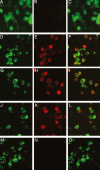LRP4 antibodies in serum and CSF from amyotrophic lateral sclerosis patients
- PMID: 25356387
- PMCID: PMC4212481
- DOI: 10.1002/acn3.26
LRP4 antibodies in serum and CSF from amyotrophic lateral sclerosis patients
Abstract
Objective: Amyotrophic lateral sclerosis (ALS) and myasthenia gravis (MG) are caused, respectively, by motor neuron degeneration and neuromuscular junction (NMJ) dysfunction. The membrane protein LRP4 is crucial in the development and function of motor neurons and NMJs and LRP4 autoantibodies have been recently detected in some MG patients. Because of the critical role in motor neuron function we searched for LRP4 antibodies in ALS patients.
Methods: We developed a cell-based assay and a radioimmunoassay and with these we studied the sera from 104 ALS patients.
Results: LRP4 autoantibodies were detected in sera from 24/104 (23.4%) ALS patients from Greece (12/51) and Italy (12/53), but only in 5/138 (3.6%) sera from patients with other neurological diseases and 0/40 sera from healthy controls. The presence of LRP4 autoantibodies in five of six tested patients was persistent for at least 10 months. Cerebrospinal fluid samples from six of seven tested LRP4 antibody-seropositive ALS patients were also positive. No autoantibodies to other MG autoantigens (AChR and MuSK) were detected in ALS patients. No differences in clinical pattern were seen between ALS patients with or without LRP4 antibodies.
Conclusions: We infer that LRP4 autoantibodies are involved in patients with neurological manifestations affecting LRP4-containing tissues and are found more frequently in ALS patients than MG patients. LRP4 antibodies may have a direct pathogenic activity in ALS by participating in the denervation process.
Figures


References
-
- Hovden H, Frederiksen JL, Pedersen SW. Immune system alterations in amyotrophic lateral sclerosis. Acta Neurol Scand. 2013 doi: 10.1111/ane.12125. [Epub ahead of print] - DOI - PubMed
-
- Rentzos M, Rombos A, Nikolaou C, et al. Interleukin-17 and interleukin-23 are elevated in serum and cerebrospinal fluid of patients with ALS: a reflection of Th17 cells activation? Acta Neurol Scand. 2010;122:425–429. - PubMed
-
- Sta M, Sylva-Steenland RM, Casula M, et al. Innate and adaptive immunity in amyotrophic lateral sclerosis: evidence of complement activation. Neurobiol Dis. 2011;42:211–220. - PubMed
LinkOut - more resources
Full Text Sources
Other Literature Sources
Miscellaneous

